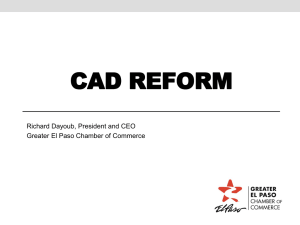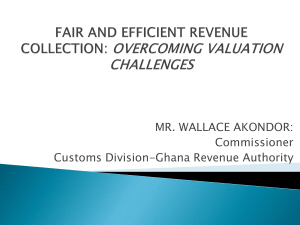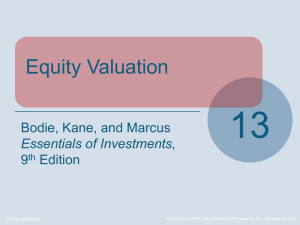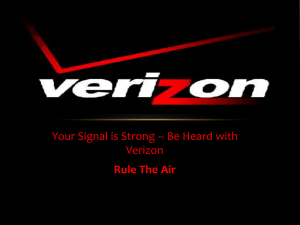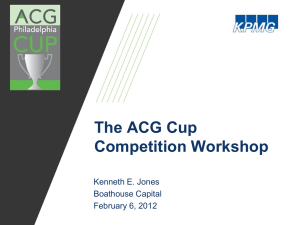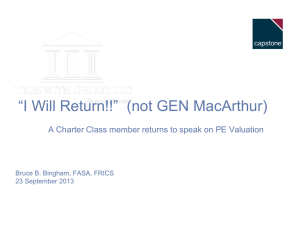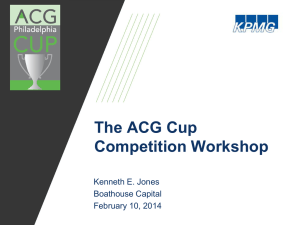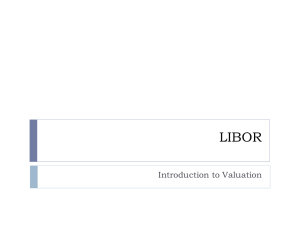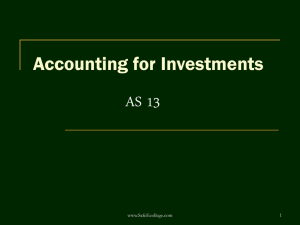Relative Valuation - University Securities Investment Team
advertisement
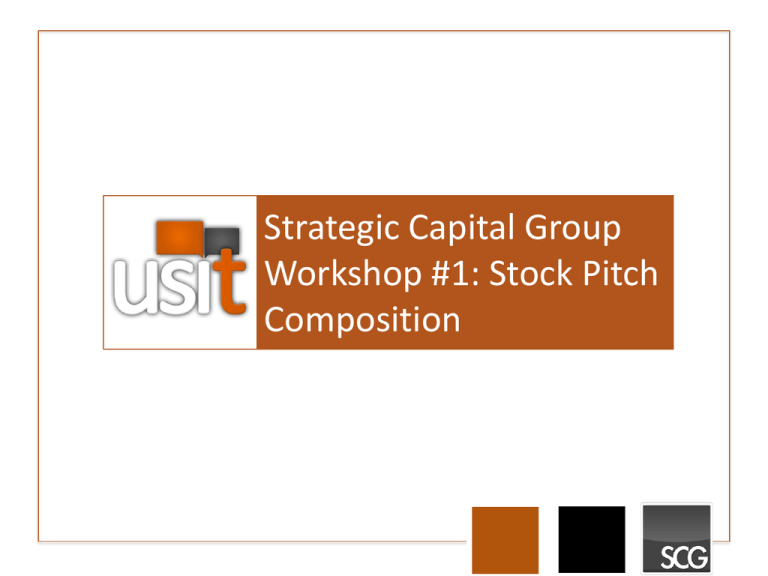
Strategic Capital Group Workshop #1: Stock Pitch Composition What does a pitch look like? Investment Thesis Company Overview and Advantage Industry and Market Analysis Valuation Risks The Investment Thesis Why do you want to invest in this company? • Reasons to invest in a company: – Value Investingpicking investments Which is the riskiest? The safest? that are trading for less than their intrinsic value. Who might be interested in each style of investing? – Growth Investing- picking investments that have potential to grow more than the market already believes. – Fixed-Income Investing- picking stable investments that can provide returns even when stagnant. The Investment Thesis • Does the stock fulfill a strategy in the overall portfolio? – Diversification- risk management strategy Name two stocks that do not correlate whereby losses in some securities is offset by gains in non-correlated securities Company Overview • What does it do? • Who’s running it? • How does it make money? • Why this company and not • Who are its competitors? competitors? Company Overview: Key Statistics • Serve as a quick financial snapshot of the business to assess its health • We want to look at: – – – – – – Are they in a lot of debt? Do they have any cash? How much money have they made in the past years? What do their margins (profitability) look like? What is the scope/size of the business? Where does it operate? Key Statistics You Saw Last Meeting Earnings History $6,000 $5,000 $4,000 4,313 4,946 4,551 Historical Revenue 5,503 30,000 25,000 $3,544 $3,000 Franchised… Company-… 20,000 15,000 2,395 $2,000 10,000 $1,000 5,000 $- 0 2006 2007 2008 2009 2010 2011 2006 2007 2008 2009 2010 2011 Operating Margin Total Restaurants 35.0% 34,000 27.4% 30.0% 33,000 25.0% 32,000 20.0% 30.1% 31.0% 31.6% 2009 2010 2011 21.2% 17.0% 15.0% 31,000 10.0% 30,000 5.0% 0.0% 29,000 2006 2007 2008 2009 2010 2011 2006 2007 2008 Other Key Statistics We Can Use Net Income (Profit) Profit Margin = Revenue (Sales) Current = Ratio Current Assets (assets we can turn into cash in one year or less) Current Liabilities (debts we have to pay this year) Historical Earnings per Share = Net Income (Profit) Shares Outstanding Competitive Advantage • Competitive Advantage- a distinct, unique advantage a company has over its competitors, it to generate What areallowing some examples of this wemore revenue, can achieve margins, or hold see inbetter real companies? customers better than others. Competitive Advantage: Exercise Sanity Check • We’ve discussed different investment ideologies • We’ve covered what to look for in a company overview and what statistics to look at • We’ve discussed examples of competitive advantages Key Terms: Value Investing, Fixed-Income Investing, Growth Investing, Diversification, Competitive Advantage Industry Analysis- Porter’s 5 Forces Threat of New Entrants Bargaining Power of Suppliers Intensity of Rivalry Threat of Substitutes Bargaining Power of Buyers Market Analysis • Questions to ask – Is instability in a region going to hurt its margins? – Are conditions pushing investors out of one asset class and into another? – Are there untapped markets waiting for this company? • Focus on global news and ask yourself if this will influence your company. Market Analysis: Exercise • How can a Euro-zone debt crisis and Chinese growth slowdown influence a company like Verizon? • How does instability in the Middle East impact margins of American Airlines? Valuation • The big cheese: what investors really care about. Is my investment going to make money? • Intrinsic vs. Relative Valuation: – Intrinsic: Valuing a company based on how much revenue/cash/profit it will generate in the future – Relative: Valuing a company by comparing it to its peers Valuation Intrinsic Valuation • Factors in a company’s future profit potential. • Both qualitative and quantitative brought together • Concerned about cash flows, as investors, we ultimately care about tangible money that can be used to pay us Relative Valuation • Factors in similar competitors in the market • If market averages for a trading multiple (P/E, P/B, P/S) are higher than your company’s, this is a sign that your company is undervalued compared to the rest of the market Intrinsic Valuation: How do we do it? 1.) Understand the company – Revenues, profitability, trends, management quality, new products, market competition, etc. 2.) Build a model – Common practice is to build a Discounted Cash Flow Model (DCF) that forecasts how much money the company will generate in the future, then finds out what that cash is worth right now. 3.) Put a price tag on the company – Find out what a company that can generate X amount of cash over the next 5 years is worth through the model and compare to the current share price. If your implied share price from the model is less than the current market price per share, you should invest. Example of a DCF Revenue Cost of Sales Gross Profit Gross Margin Projected 2011 2012 2013 2014 2015 $27,006.0 $28,356.3 $29,774.1 $30,965.1 $31,894.0 $10,231.6 $10,579.5 $10,928.6 $11,278.3 $11,560.3 $16,774.4 $17,776.8 $18,845.5 $19,686.8 $20,333.8 62.1% 62.7% 63.3% 63.6% 63.8% Assumptions 2016 $32,531.9 $11,791.5 $20,740.4 63.8% SG&A Expenses EBIT EBIT Margin $8,342.6 $8,843.16 $9,329.53 $9,702.71 $9,993.79 $10,193.67 $8,431.8 $8,933.7 $9,516.0 $9,984.1 $10,340.0 $10,546.8 31.2% 31.5% 32.0% 32.2% 32.4% 32.4% NOPAT D&A Change in NWC CapEx FCF DCF $5,649.3 $1,329.6 ($550.0) $2,730.0 $4,798.9 Terminal Value Enterprise Value $5,985.6 $1,412.4 $750.0 $2,900.0 $3,748.0 $3,569.5 $6,375.7 $1,468.9 ($575.0) $3,016.0 $5,403.6 $4,901.2 $6,689.3 $1,498.3 $500.0 $3,076.3 $4,611.3 $3,983.4 $6,927.8 $1,513.3 ($225.0) $3,107.1 $5,558.9 $4,573.4 $7,066.3 $1,513.3 $150.0 $3,107.1 $5,322.5 $4,170.3 $ 133,625.04 $ 125,896.49 WACC 5% Tax Rate 33% Exit Multiple Share Price 11.08 $ 98.62 Calculations Enterprise Value $ 125,896.49 Less Net Debt $ 10,164.70 Equity Value $ 115,731.79 Shares Outstanding Value Per Share Implied Discount 1018.6 $ 113.62 15.19% Sanity Check • We’ve learned Porter’s 5 Forces, a method of evaluating an industry • We’ve learned that global market forces should be considered when evaluating a stock • We’ve learned what intrinsic valuation is and received a rough outline of how to use it Key Terms: Porter’s 5 Forces, Intrinsic Valuation, Relative Valuation, Discounted Cash F Relative Valuation: How do we do it? 1.) Determine peers of your company – Look at industry, size, geography – What good is comparing Apple to Verizon? – Competitors are on the 10-K’s most of the time 2.) Assemble company multiples or “comparables” – Find multiples like P/E, P/B, EV/EBITDA for your company and its chosen peers – Resources for this: Yahoo Finance, Bloomberg, CNBC 3.) Compare multiples between companies – For value investing, you want your stock to be trading at less than market value (lower multiple than the averages) – Based on these numbers, we can calculate an implied share price Relative Valuation Target company: Step 1: Assemble peers of the company Relative Valuation Step 2: Assemble company comparables P/E 2010 = 18 P/E 2011 = 17 Estimated P/E 2012 = 16 P/B 2010 = 1.4 P/B 2011 = 1.3 P/B 2012 = 1.2 P/E 2010 = 22 P/E 2011 = 25 Estimated P/E 2012 = 21 P/B 2010 = 1.6 P/B 2011 = 1.8 P/B 2012 = 1.5 Etc. Compare the multiples Company P/E 2010 P/E 2011 P/E 2012 P/B 2010 P/B 2011 P/B 2012 ATT 22.0x 25.0x 21.0x 1.6x 1.8x 1.5x T-Mobile 21.0x 22.0x 18.0x 1.9x 2.2x 1.5x Sprint 25.0x 24.0x 20.0x 2.5x 2.2x 0.6x Average 22.7x 23.7x 19.7x 2.0x 2.1x 1.2x Verizon 18.0x 17.0x 16.0x 1.5x 1.4x 1.3x So we know it’s undervalued… But how do we know by how much? BY USING ALGEBRA! We make a key assumption to determine an implied share price through multiples: • In the long run, our multiple will equal the industry average for that same multiple, so… Relative Valuation Verizon Price = Verizon Earnings Per Share Industry Price to Earnings Multiple If we want to find what our stock is worth comparison industry, So based oninthe 2012 Pricetotothe Earnings solve for Verizon Price. multiple, Verizon should be worth $50.93 an implied discount of 11% to its current price of $45.90 Industry P/E X = Verizon Price Verizon Price = = 23.7x $ 50.93 X Verizon EPS $2.15 Risks • Every company has something wrong with it or has a chance for failure • Found in 10-K, but we want real risks • Two kind of risks: – Company-specific – Industry-wide – Technically market-wide risks too, but those aren’t relevant as they are going to be present in nearly every potential company. • You’re not helping anyone if you give bullshit risks, it can only hurt you if you look past serious problems with the company. Sanity Check • We’ve learned how to perform a relative valuation of a company • We’ve learned how to extrapolate a share price from a multiple comparison • We’ve learned the two kinds of risks and the value of being honest Announcements • PAY DUES • UIA Stock Pitch Competition coming up on Sept. 29, make a USIT team and go kick ass. – Need help building your pitch or making it a bit more in-depth? Talk to any SCG member • SimComp takes place on October 4th, next workshop we’ll be working on how to trade on news and trade quickly maybe • Stock Pitch teams will be formed before next meeting- notifications will be sent by EMAIL


